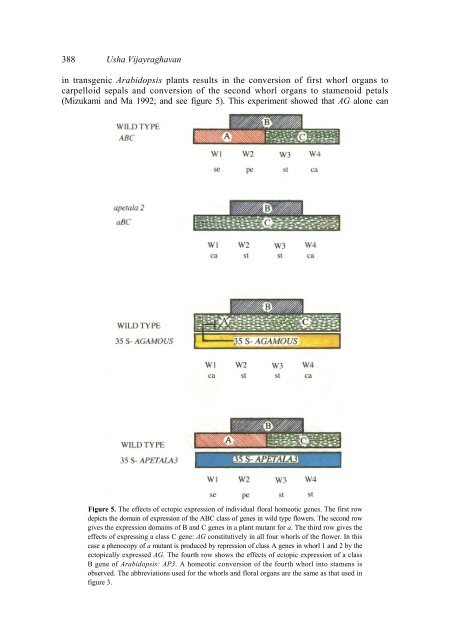Genetic regulation of flower development - Indian Academy of ...
Genetic regulation of flower development - Indian Academy of ...
Genetic regulation of flower development - Indian Academy of ...
You also want an ePaper? Increase the reach of your titles
YUMPU automatically turns print PDFs into web optimized ePapers that Google loves.
388 Usha Vijayraghavan<br />
in transgenic Arabidopsis plants results in the conversion <strong>of</strong> first whorl organs to<br />
carpelloid sepals and conversion <strong>of</strong> the second whorl organs to stamenoid petals<br />
(Mizukami and Ma 1992; and see figure 5). This experiment showed that AG alone can<br />
Figure 5. The effects <strong>of</strong> ectopic expression <strong>of</strong> individual floral homeotic genes. The first row<br />
depicts the domain <strong>of</strong> expression <strong>of</strong> the ABC class <strong>of</strong> genes in wild type <strong>flower</strong>s. The second row<br />
gives the expression domains <strong>of</strong> Β and C genes in a plant mutant for a. The third row gives the<br />
effects <strong>of</strong> expressing a class C gene: AG constitutively in all four whorls <strong>of</strong> the <strong>flower</strong>. In this<br />
case a phenocopy <strong>of</strong> a mutant is produced by repression <strong>of</strong> class A genes in whorl 1 and 2 by the<br />
ectopically expressed AG. The fourth row shows the effects <strong>of</strong> ectopic expression <strong>of</strong> a class<br />
Β gene <strong>of</strong> Arabidopsis: AP3. A homeotic conversion <strong>of</strong> the fourth whorl into stamens is<br />
observed. The abbreviations used for the whorls and floral organs are the same as that used in<br />
figure 3.

















